The role of women of color donors is coming to the fore. For example, a cover story in the March issue of the Chronicle of Philanthropy asks “How to Connect With Donors of Color?”
Groups like Chicago Foundation for Women, CFW, that have prioritized the investment of women of color donors’ “treasure, time, talent and testimony,” have been leading the way in understanding and connecting with diverse communities of women.
Last year, CFW enlisted BECOME to develop a focused research project to explore philanthropy’s progress engaging and partnering with women of color, with support from W.K. Kellogg Foundation. Given the interest and importance of the topic to the foundation and nonprofit sector, we share here this in-depth look at our research.
Research process
Over the last three years, Chicago Foundation for Women leaders have been developing new strategies to:
- Engage new and diverse donors
- Ensure donors reflect communities they and their grantee partners serve
- Continue to build a more responsible and democratic philanthropic sector through increasing engagement of communities of color in philanthropy
They engaged BECOME to build on their efforts. We designed a Culturally Responsive Evaluation approach to conduct the research and learning process regarding strategies Chicago Foundation for Women was and could be using to diversify its donor base.
BECOME facilitated a visioning session with representatives from the Foundation’s Giving Circles and Giving Councils, board, staff, and selected community leaders. This process helped us frame a set of evaluation questions of concern to both CFW leaders and women philanthropists generally.
We then provided training for a group of women of color who constituted CFW’s Committee for Community Engagement and Evaluation (the Committee) on research and evaluation methods. This allowed them to effectively engage their networks, complete interviews and focus groups, and assist in analyzing the data.
A total of 592 women participated in the evaluation. Over 541 people completed the survey. Roughly half indicated they were of a European American background (a term we use instead of “White” to recognize history and ethnic background and to prevent perpetuating a metaphor of ‘whiteness’) and half had other cultural/ethnic backgrounds. The Committee engaged 34 people in interviews and focus groups that represented various communities in Chicago that were both age and ethnically diverse. We also directly interviewed and held focus groups with CFW staff and leadership.
In February 2020, we shared the results and presented several recommendations to a cross section of Chicago Foundation for Women leaders, grantees, and the community.
Insights
All donors said they look to foundations and nonprofits to:
- Develop a relationship with a donor
- Appreciate a gift and its giver
- Show the impact of a contribution on the cause or organization
However, women of color articulated a distinct set of interests that differentiated them from the group as a whole: an appreciation of intersectionality, a non-negotiable desire that the organization reflect the community it serves, and the importance of giving to aid a specific community.
More details are in the report itself, but here are some additional highlights:
Intersectionality
“White women don’t have to see [intersectionality]. We die if we don’t,” one interview participant said. Women of color, especially those who live in marginalized communities or have less income likely face multiple systemic barriers to opportunity.
We understood the interviewee as expressing a preference to invest in organizations and leaders who appreciate how multiple systems – healthcare, employment, and justice, for example — can interact with deadly efficiency to harm people of color.
A survey respondent echoed this theme: “I have not given in the past… because an organization lacked an intersectional analysis, or because they were not led by the communities they were working with.”
Reflect the community within the organization
Leadership who reflect the makeup of the community they serve is almost non-negotiable for many women of color donors we interviewed. “I strongly believe that organizations should reflect the communities they serve — from entry level to leadership,” one respondent said.
Supporting specific communities
Women of color were substantially more likely to agree with the statement “I am more likely to donate to organizations / causes that further the needs of a particular community.”
As one interviewee put it, it’s essential to understand and support the specific needs of a particular community that may arise from the experiences of its residents: “Something important for them to know, and I speak from my experience as a Latina immigrant, is to be open to the way we are and our opinions, and how we communicate…. [M]y recommendation is for them to know us, so when we suddenly react defensive they will understand.”
Conclusions
Based on our learnings we offered two key recommendations to Chicago Foundation for Women and other foundations and nonprofits interested in being more responsive to women of color donors.
Adapt a cultural humility mindset
Findings from the evaluation can be interpreted through a broader lens of cultural humility. As the graphic shows, it can be constituted by:
- Critical self-reflection
- Valuing the person/community
- Openness and learning from the community
- Building a relationship with the community
These aspects are not mutually exclusive; they overlap and are influenced by one another, helping to further define and enhance the other aspects. Further details are in the full report.
Listening and engaging
In a similar vein, foundations and nonprofits can benefit from engaging in additional efforts directed toward listening and learning from, as well as educating and responding to the concerns of, women of color donors. The infographic below outlines these core processes.
During our work developing the Time, Treasure, Talent & Testimony report, we came across the work of the Colorado Health Foundation. This foundation required staff to spend 40% of their time in and with community members and organizations. Its approach is highlighted in an appendix included with the full report.
More detail on our process and findings are in the report. The full report and executive summary, Time, Treasure, Talent & Testimony: Giving by Women of Color in Chicago are available here.





